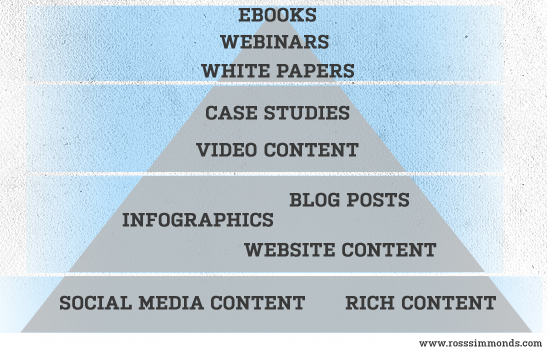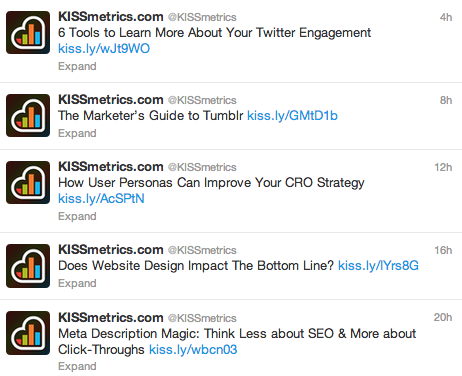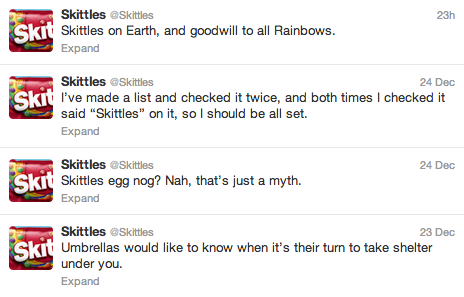As someone who is looking to learn about content marketing, you’re probably confused on where you should start, right? With all of the different types of content out there, which ones should you follow and which ones should you ignore?
Over the last five years or so of leveraging content marketing for clients and my own businesses; I’ve found what I call the perfect mix. The mix differs from one business to the next but for the most part you can use these various types of content across multiple industries. While every content marketing strategy and approach is different, I’ve created the below chart to show some of the key and most effective types of content that will keep your content strategy on track.

The implementation of a great content marketing strategy does two thing very well…captures attention & tells your story. Unless you’ve developed a premium brand with a wide range of conversations already happening about your business; understand that in the minds of many, you do not exist. You’re simply one of a million businesses and brands competing for attention. With great content marketing you go from competing…to capturing. Here are the levels of content that will help you capture the attention of your audience:
The Content Foundation: Social Media & Rich Content
The times they are a-changin’. These famous words from the great Bob Dylan come to mind immediately when I think about the fragmented ecosystem of today as it relates to brand communication.
A brands story needs to be told 365 days a year through content across a variety of different networks. This is important because while you may not be communicating to consumers about your brand for 365 days a year; they will be communicating about you. The story you tell over the course of the year through social media must be consistent and tell your brands story. As you tell this story, recognize that it is being told in a manner that must communicate the value proposition of your business but also your brands essence.
Content Creation & Syndication
Success in social media is determined based on an organizations ability to create and syndicate content. The ability to syndicate content isn’t challenging but it’s an art to understand how to syndicate content from third parties that assist in telling your brands story. Content syndication is what happens when a brand shares content as it relates to the interest of their target audience from third party websites. A great example of a brand using content syndication is KissMetrics:
Over the course of the year, KissMetrics share a variety of content that would be valuable to their target audience. Selling an online Analytics/Marketing product; they ensure that the content they share through twitter provides value to marketers and analysts. Whether it’s content directly from their blog or an interesting answer to a question they found on Quora, they syndicate only the best of the web.
The most difficult yet rewarding approach to social media is a brands ability to create unique, compelling content. While this is a challenge across all channels, the challenge for brands on social media is related to the challenge of telling a story that is worth sharing on a daily basis. The biggest challenge that brands are met with when it comes to social media is recognizing that the content they share can’t be focused around THEM and needs to be focused around the community they are developing. Brands who understand this, use unique tactics like reactive storytelling to keep the feeds of their target audience filled with brand relevant content that is worth engaging with. An example of a brand who understands this is Skittles:
The Middle: Website Content, Blog Posts & Infographics
I was having this conversation with a colleague the other day after she pointed out that content isn’t only about blog posts, infographics, tweets and status updates. The reality is, while these types of content may be the sexiest in the marketing mix, they are far from the end-all-be-all when it comes to content marketing.
This content is what many would consider the most important pieces of your content strategy. In many ways, I agree that it’s important to ensure that these pieces are healthy and together to tell a consistent brand story. At the same time, I understand why it’s so daunting to create these pieces of content in a way that actually provides great value to your customers and audience.
- Website Content: Of all the content you develop, this is the content where you will need to make the sale. It’s the content that will live on your homepage but also the content that you will create and host on landing pages for your audience to find through Google PPC campaigns. You can spend ridiculous amounts of time and money optimizing this content through A/B testing and user experience design to drive sales and potential leads.The content you create and place on your website will act as the story that defines you. If you’re offering a product like Coffee, this content is going to tell the story behind your coffee and the brand essence surrounding this idea. If you’re a social media marketing company, then you’ll write about social media along with your approach to developing a strategy.
- Blog content – Developing a blog is an easy way to provide your customers with an opportunity to build a deeper connection with your brand. Whether you’re sharing stories about your team or sharing content that will interest your entire industry; most of your readers will place the most value in what you have to say about your area of expertise. However, you should not neglect to share personal information whether separately or as part of your content. This is a tactical yet effective approach to building authentic relationships with readers and customers.
- Infographics – Finally, you should occasionally develop content like infographics that are unique and link bait worthy. Infographics are just one of the many types of content that drive an increase in back-links and brand relevant conversation. You can also develop content that goes against conventional wisdom or content that provides huge value like I did with this great list of books to read about advertising.
This is the piece of your content marketing pyramid that is crucial to achieving success. If you make the mistake of ignoring quality website copy, rich visuals and compelling blog posts, your content marketing program will be destined for failure and shortcomings.
Use your website content to tell what you do, your blog posts to tell why you do it and engaging pieces of content like info graphics to deliver your key value proposition. None of these pieces of content stand alone in the middle of the content marketing pyramid. If you don’t embrace compelling website copy, the chances of your blog’s readers becoming qualified leads and potential customers are low.
The Chin: Case Studies & Video Content
It’s challenging to sell someone something if they can’t see the value proposition behind your product and service. The best way to show people why your product is worth using is by showing the examples of how it has worked for others with a similar need. The utilization of Case Studies have been used in Marketing and Creative circles for years and just recently have they also become beneficial to businesses and startups.
You see, no matter how compelling, informative, and brilliant your blog posts and website copy may be, potential customers are going to want to know who else has worked with you successfully. It’s simply the way humans work. We need validation and we need to know we’re not giving our resources away to someone who won’t provide us with a return. To combat this, short, precise and jaw-dropping case studies are an extremely effective way to assist your organization in closing a sale.
Everyone consumers content differently, some users will read your content word for word and others will simply press play on an explainer video. While videos aren’t an absolutely essential part of your content marketing mix, they will give your website a ridiculous amount of legitimacy and can easily communicate a complex message through both visuals, voice overs and text. If the budget is there, you can take it up a notch and develop a video that is unique, engaging and worth sharing. Pro tip: to save money, use free text to voice tools to give your video a voiceover.
It’s very rare that you can create video gold like the Dollar Shave Club viral sensation.
The reason for this video going viral wasn’t because it was just “ok”. In fact, the people who created this video probably rolled around laughing for hours after watching this clip. Furthermore, they ensured that the video was of high quality and delivered a message that was captivating and worth sharing. There was no instances of watering down the message and they embraced the idea of combining a brand relevant message with one that was hilarious.
The Top: Ebooks, Webinars and White Papers
Content such as webinars and eBooks are the most effective forms of content marketing for driving sales. People are generally willing to submit their contact information in exchange for significant content like this. Once you have that, your sales team can contact any qualified leads.
The key to success through these forms of content is the ability to establish a level of expertise for your brand. You must initially develop a story around your brand that indicates and communicates that you know your industry better than anyone else. If you cant convince your target audience that you can provide them with a deep level of knowledge and understanding; it will be difficult to convince them to take time out of their day to consumer you white paper, webinar or ebook.
While it’s a catch-22 situation, the reality is that these types of content marketing can drive sales when done correctly. The people who indicate interest in these pieces of content are typically going to be potential customers. You don’t have to have each of these types of content but identify what kinds of content you can deliver to people that offers true value. Content that they will feel is worth providing you with their email, phone number or mailing address. If you can provide that kind of value; you can provide your sales team with leads that are meant to be closed.
Conclusion
Content marketing is changing the way we communicate on both social and digital channels. It’s an evolution of the sales funnel and is built on the idea of providing value to elevate the value of your business as a whole. Content marketing is an avenue to leverage networks and channels to make consumers love you, trust you and adore you.
Do you have any content marketing tips or types of content that should be included in the Pyramid?


